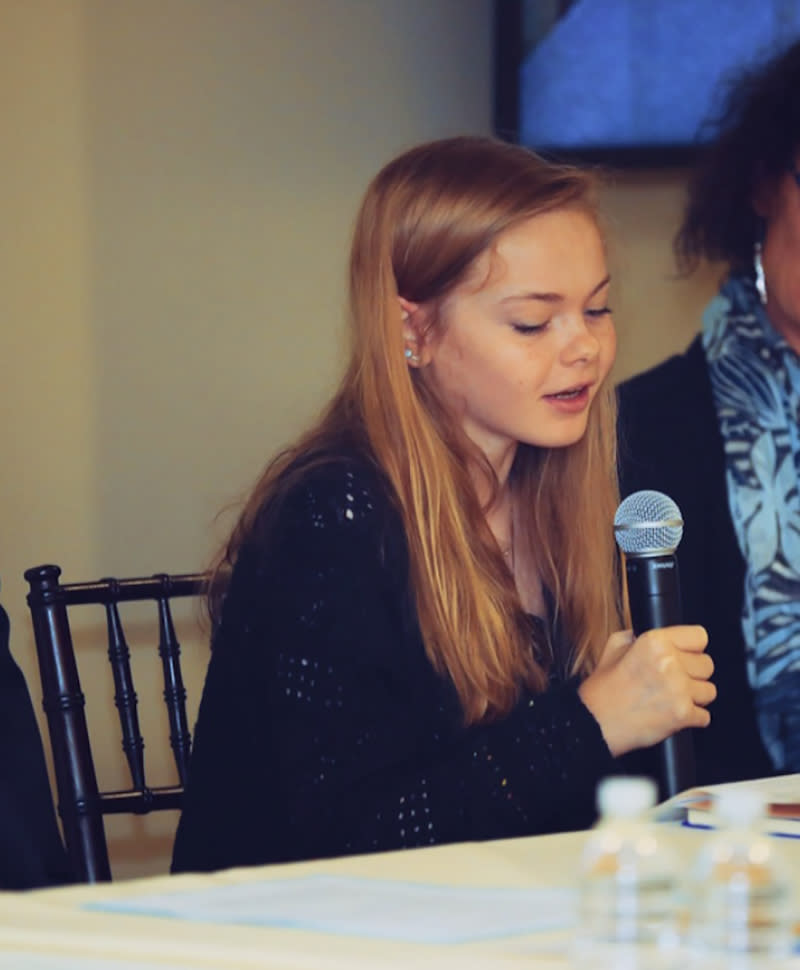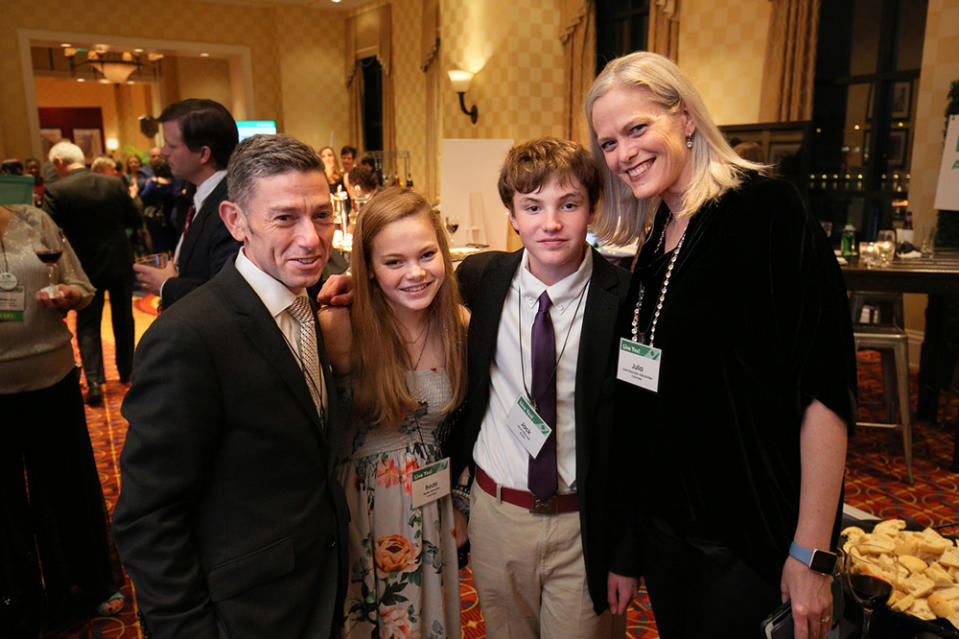What it's like to struggle with painful arthritis as a teenager: 'I had a time when I couldn't squeeze the toothpaste or brush my hair'

When 14-year-old Bede Marciari tries to trace back to where it all started — ground zero for her developing painful and debilitating arthritis at such a young age — her mind goes to her 13th birthday in 2017.
“We went down to spend some time with my grandfather in Virginia and noticed I had a kind of a very sore throat,” she tells Yahoo Lifestyle. “I went to the doctor and they tested me for strep four times, and it all came back negative. That eventually went away.”
A month later, Bede noticed that her fingertips felt sore, making it hard to even button her shirt. Then she fell on her wrist while playing tennis. “It didn’t really hurt, but I knew something was off,” she says. Bede went to get checked out at the urgent-care clinic Patient First, but they didn’t find anything on the x-ray, so they sent her home with a splint.
The next day, she left for spring break and things got progressively worse. “I was walking around a museum and started to limp and could not walk on my ankle,” she recalls. “After a couple of hours of not being able to walk, I went to Patient First again.”
The fact that she was having an issue with two different joints — her wrist and her ankle — started to raise a red flag, but doctors still couldn’t pinpoint what was causing the joint problems.
By the end of Bede’s spring break, she needed a wheelchair to go through the airport to get home.

But her mysterious symptoms didn’t stop there. Bede’s entire hand callused over, and then it all started to peel off. Her mom, Julia Marciari-Alexander, thought her daughter was having a reaction to the self-tanning cream the teen had used. That was followed by red splotches cropping up on Bede’s knuckles and elbows, which could also easily be chalked up to another allergic reaction.
Another x-ray revealed little information, and Bede was sent home with a splint once again.
But Bede and her family didn’t give up. After seeing several doctors, Bede finally got a diagnosis from Johns Hopkins: psoriatic arthritis. The condition causes joint pain, stiffness and swelling as well as red patches and flaky skin.
“We found out that an undiagnosed throat virus, not strep but something that feels like strep, can sometimes be the onset.” So it’s possible that the sore throat Bede had while visiting her grandfather in Virginia may have been the trigger, though Bede points out she remembers having joint pain even before then.
For Bede, finally putting a name to her pain didn’t provide some relief. “I had a lot of bigger things on my mind,” she shares. From March to June of 2017, the teen had gone from weighing 105 pounds to only 72. “I had lost all of my muscle,” says the formerly athlete teen. “I stopped leaving the room, sleeping basically all day. I remember one day walking up and my knees being gigantic overnight. It was so crazy to me that it was all happening so fast. And treating it was so slow.”

Bede says she went on a downward spiral. “I stopped going to school, and I lost all of the [social] connections,” she says. “My whole world was different. I didn’t do anything the same anymore.”
She recalls one day when her mom left for work before the teen had taken her over-the-counter pain medication. “She left an Advil bottle by the bed,” Bede says. “I called her and said I couldn’t even open it. That had never happened before.”
For mom Julia, however, getting the diagnosis at first was “fabulous because it meant we were seeing the right doctor, we had a plan — everything was going to get better once we had the diagnosis,” she shares with Yahoo Lifestyle. “For me, the worst thing was realizing this was not something that’s necessarily going to be a one and done. It could be once we’re in remission. But realizing your child has the potential of being affected by this forever, that is really upsetting.”
Bede was put on prescription medications, but she fell into the category of people who don’t find significant pain relief from the drugs.
“Once we got the diagnosis, my parents thought, Oh, we’re out of it, but then everyone’s hopes were shattered when the first medicine didn’t work, and the second medicine didn’t work and the third medicine didn’t work.”

But Julia remains hopeful thanks to the “extraordinary care” her daughter has received and seeing doctors who specialize in Bede’s condition. “So we’re really homing in on attacking the specific disease that we think she has,” Julia says.
The high doses of Aleve Bede takes help manage her pain to a certain extent. “When you’re arthritic and you don’t move, you hurt because you’re stiff, and when you’re arthritic and you move too much you’re sore. So you have to find the balance.”
Dealing with the condition at such a young age was eye-opening for Bede. “Even for me, when I thought of the word arthritis, I thought of an old person,” she says. “People should know there’s a variety of different types of arthritis, and just because you see one case, that’s not how every case is. Everyone is different.”
She adds: “In my school it was very hard because people couldn’t understand why I couldn’t come to school. With other injuries like sports injuries, school makes it easy for the student to take care of themselves and participate, but for me it was hard to do that.”
Although she says it’s easy to fall into a downward spiral when the stiffness and pain are debilitating, Bede strives to focus on the positive. “When I’m having a bad day, you should surround yourself with a positive environment because that really helps me,” she says. “I had a time when I couldn’t squeeze the toothpaste or brush my hair — those were things I took for granted. I’ve appreciated the little things way more, such as opening a can.”

Her condition has also given her some incredible opportunities. Although Bede missed doing the model U.N. with her school in eighth grade because she wasn’t well enough to attend, she was able to speak at the real U.N. — on behalf of NCD Child, a coalition championing the rights and needs of children and young people living with or at risk of developing noncommunicable diseases — just a few months later.
“It was a really cool experience,” Bede says. “I couldn’t do eighth-grade model U.N. because I couldn’t get out of bed. It had made me sad that I had missed out on that experience. A couple of month later, I had the opportunity to speak at the U.N.”
Bede has also raised $16,000 for the Arthritis Foundation through the Walk for a Cure, while her mom, Julia, raised $5,000 doing the Jingle Bell Run.
Julia is proud of her daughter’s strength and her accomplishments. “She’s finding her voice,” she says, “and thinking about how to use the negative in her life and make it into something positive for others.”
Read more from Yahoo Lifestyle:
Follow us on Instagram, Facebook and Twitter for nonstop inspiration delivered fresh to your feed, every day.


